Deformation and Stress Analysis of Pile-Supported Immersed Tunnels under Seismic Loads
Abstract
:1. Introduction
2. Methodology
2.1. Physical Modelling Overview
2.1.1. Materials and Similarity Principle
2.1.2. Overburden and Seismic Waves
2.2. Numerical Model
2.2.1. FEM Mesh and Boundary Conditions
2.2.2. Material Properties
2.2.3. Viscoelastic Boundary and Seismic Loads
3. Verification of Numerical Model
3.1. Convergence Analysis of Numerical Model
3.2. Verification of the Results
4. Parametric Analysis
4.1. Effects of the Seawater Depth
4.1.1. Peak Stresses in the Top and Bottom Plates of the Tunnel
4.1.2. Displacement of the “H-Shaped” Structures
4.2. Structural Response in Different Directions
4.2.1. Settlement of Gravel Cushion
4.2.2. Vertical Strain of the Gravel Cushion
4.3. Effects of the Slenderness Ratio
4.3.1. p-y Curve of the Piles
4.3.2. Soil Displacement around the Pile
5. Conclusions
- (1)
- Increased seawater pressure suppresses the vertical frequency of the tunnel. The suppression is enhanced by the deformation of the tunnel’s “H-shaped” structures and stress transfer in the tunnel wall when the pile replacement rate reaches 50%.
- (2)
- The vertical frequency at the far end of the immersed tunnel from the source is similar to the seismic excitation frequency along the width of the tunnel, resulting in resonance. The seismic injury at the distal end is amplified.
- (3)
- The soil densification is higher at the end of the pile when the seawater pressure increases and the lateral earth pressure increases, resulting in a large change in the slope of the p-y curve at the tip of the pile. The increase in pile slenderness ratio (γ) will increase the axial force of the pile to produce an additional bending moment, resulting in large changes in the slope of the p-y curve at the end of the pile with larger axial force. When the slenderness ratio is in the range of 9.25 to 15, it can reduce the injury at the connection between piled foundations and tunnels.
Author Contributions
Funding
Institutional Review Board Statement
Informed Consent Statement
Data Availability Statement
Conflicts of Interest
References
- Olsen, T.; Kasper, T.; de Wit, J. Immersed tunnels in soft soil conditions experience from the last 20 years. Tunn. Undergr. Space Technol. 2022, 121, 104315. [Google Scholar] [CrossRef]
- Fu, B.-Y.; Chen, W.-L.; Xu, G.-P.; Song, S.-Y.; Xia, F.-Y. Summary of the Development of New Technologies for Submarine Immersed Tunnel Foundation Reinforcement and Settlement Control. IOP Conf. Ser. Mater. Sci. Eng. 2020, 741, 012052. [Google Scholar] [CrossRef]
- Grantz, W.C. Steel-Shell Immersed Tunnels-Forty Years of Experience. Tunn. Undergr. Space Technol. 1997, 12, 23–31. [Google Scholar] [CrossRef]
- Yu, H.; Yuan, Y.; Xu, G.; Su, Q.; Yan, X.; Li, C. Multi-point shaking table test for long tunnels subjected to non-uniform seismic loadings—Part II: Application to the HZM immersed tunnel. Soil Dyn. Earthq. Eng. 2018, 108, 187–195. [Google Scholar] [CrossRef]
- Lin, K.C.; Hung, H.H.; Yang, J.P.; Yang, Y.B. Seismic analysis of underground tunnels by the 2.5D finite/infinite element approach. Soil Dyn. Earthq. Eng. 2016, 85, 31–43. [Google Scholar] [CrossRef]
- Abate, G.; Massimino, M.R. Parametric analysis of the seismic response of coupled tunnel–soil–aboveground building systems by numerical modelling. Bull. Earthq. Eng. 2016, 15, 443–467. [Google Scholar] [CrossRef]
- Zhang, G.; Wang, P.; Zhao, M.; Du, X.; Zhao, X. Seismic structure-water-sediment-rock interaction model and its application to immersed tunnel analysis under obliquely incident earthquake. Tunn. Undergr. Space Technol. 2021, 109, 103758. [Google Scholar] [CrossRef]
- Wang, Z.Z.; Jiang, L.; Gao, Y. Shaking table test of seismic response of immersed tunnels under effect of water. Soil Dyn. Earthq. Eng. 2019, 116, 436–445. [Google Scholar] [CrossRef]
- Zhao, K.; Zhu, S.; Bai, X.; Wang, Q.; Chen, S.; Zhuang, H.; Chen, G. Seismic response of immersed tunnel in liquefiable seabed considering ocean environmental loads. Tunn. Undergr. Space Technol. 2021, 115, 104066. [Google Scholar] [CrossRef]
- Zhao, W.; Gao, H.; Chen, W.; Xie, P. Analytical study on seismic response of subsea tunnels in a multi-layered seabed subjected to P- and SV-waves. Tunn. Undergr. Space Technol. 2023, 134, 105015. [Google Scholar] [CrossRef]
- Yang, Y.B.; Zhou, Z.Y. Seabed seismic analysis using exact responses of solid-liquid free field for 2D oblique incident waves by finite/infinite element method. Ocean. Eng. 2023, 285, 115171. [Google Scholar] [CrossRef]
- Zhang, S.; Yuan, Y.; Li, C.; Chen, H.; Chen, Z. Seismic responses of long segmental immersed tunnel under unfavorable loads combination. Transp. Geotech. 2021, 30, 100621. [Google Scholar] [CrossRef]
- Aarthi, N.; Dodagoudar, G.R. Three-Dimensional Finite-Element Analysis of Pressure–Settlement Response of Sand Compaction Pile-Treated Cohesionless Deposits. Int. J. Geomech. 2021, 21, 04021019. [Google Scholar] [CrossRef]
- Padmanabhan, G.; Shanmugam, G.K. Liquefaction and reliquefaction resistance of saturated sand deposits treated with sand compaction piles. Bull. Earthq. Eng. 2021, 19, 4235–4259. [Google Scholar] [CrossRef]
- Su, D.; Wu, Z.; Lei, G.; Zhu, M. Numerical study on the installation effect of a jacked pile in sands on the pile vertical bearing capacities. Comput. Geotech. 2022, 145, 104690. [Google Scholar] [CrossRef]
- Hongtao, H.; Li, J.; Lin, Y. A large-scale field test on sand compaction piles including three-dimensional numerical analysis. Int. J. Comput. Appl. Technol. 2020, 6, 296–306. [Google Scholar] [CrossRef]
- Yadav, S.K.; Ye, G.-L.; Khalid, U.; Fukuda, M. Numerical and centrifugal physical modelling on soft clay improved with floating and fixed sand compaction piles. Comput. Geotech. 2019, 115, 103160. [Google Scholar] [CrossRef]
- He, H.; Lin, Y.; Li, J.; Zhang, N. Immersed tunnel foundation on marine clay improved by sand compaction piles. Mar. Georesour. Geotechnol. 2017, 36, 218–226. [Google Scholar] [CrossRef]
- Kiani, K. A nonlocal meshless solution for flexural vibrations of double-walled carbon nanotubes. Appl. Math. Comput. 2014, 234, 557–578. [Google Scholar] [CrossRef]
- Hossain, M.Z.; Abedin, M.Z.; Rahman, M.R.; Haque, M.N.; Jadid, R. Effectiveness of sand compaction piles in improving loose cohesionless soil. Transp. Geotech. 2021, 26, 100451. [Google Scholar] [CrossRef]
- Heo, Y.; Jeong, G.C.; Bae, W.S. Evaluation of the Effect of Penetration Ratios on Composite Grounds Improved with Sand Compaction Piles. Mar. Georesour. Geotechnol. 2014, 33, 253–263. [Google Scholar] [CrossRef]
- OuYang, H.; Dai, G.; Gao, L.; Wang, A.; Gong, W. Lateral response of monopile reinforced by cement-improved soil in clay to monotonic and cyclic loadings: Laboratory model test and theoretical investigation. Mar. Struct. 2023, 89, 103403. [Google Scholar] [CrossRef]
- Askarinejad, A.; Wang, H.; Chortis, G.; Gavin, K. Influence of scour protection layers on the lateral response of monopile in dense sand. Ocean. Eng. 2022, 244, 110377. [Google Scholar] [CrossRef]
- Spyridis, M.; Lopez-Querol, S. Numerical investigation of displacement pile installation in silica sand. Comput. Geotech. 2023, 161, 105591. [Google Scholar] [CrossRef]
- Trojnar, K. Experimental and Numerical Investigation of Lateral Loaded Flexible Hybrid Piles in Sand. Int. J. Civ. Eng. 2022, 21, 1–18. [Google Scholar] [CrossRef]
- Kiani, K. Axial buckling analysis of vertically aligned ensembles of single-walled carbon nanotubes using nonlocal discrete and continuous models. Acta Mech. 2014, 225, 3569–3589. [Google Scholar] [CrossRef]
- Chen, B.; Lin, B.; Zhao, X.; Zhu, W.; Yang, Y.; Li, Y. Closed-form solutions for forced vibrations of a cracked double-beam system interconnected by a viscoelastic layer resting on Winkler–Pasternak elastic foundation. Thin-Walled Struct. 2021, 163, 107688. [Google Scholar] [CrossRef]
- Chen, L.; Xu, D.; Du, J.; Zhong, C. Flexural Vibration Analysis of Nonuniform Double-Beam System with General Boundary and Coupling Conditions. Shock. Vib. 2018, 2018, 5103174. [Google Scholar] [CrossRef]
- Kiani, K. In- and out-of-plane dynamic flexural behaviors of two-dimensional ensembles of vertically aligned single-walled carbon nanotubes. Phys. B Condens. Matter 2014, 449, 164–180. [Google Scholar] [CrossRef]
- Kiani, K. Nonlocal free dynamic analysis of periodic arrays of single-walled carbon nanotubes in the presence of longitudinal thermal and magnetic fields. Comput. Math. Appl. 2018, 75, 3849–3872. [Google Scholar] [CrossRef]
- Kiani, K.; Pakdaman, H. Nonlocal vibrations and potential instability of monolayers from double-walled carbon nanotubes subjected to temperature gradients. Int. J. Mech. Sci. 2018, 144, 576–599. [Google Scholar] [CrossRef]
- Niu, Y.; Xie, Y.; Zhang, H.; Yue, X.; Han, Y.; Hu, Z. Study on bearing characteristics of marine subsoil for semi-rigid immersed tunnel. Mar. Georesour. Geotechnol. 2021, 40, 1171–1183. [Google Scholar] [CrossRef]
- Kou, K.P.; Yang, Y. A meshfree boundary-domain integral equation method for free vibration analysis of the functionally graded beams with open edged cracks. Compos. Part B Eng. 2019, 156, 303–309. [Google Scholar] [CrossRef]
- Ma, X.; Roshan, M.; Kiani, K.; Nikkhoo, A. Dynamic Response of an Elastic Tube-like Nanostructure Embedded in a Vibrating Medium and under the Action of Moving Nano-Objects. Symmetry 2023, 15, 1827. [Google Scholar] [CrossRef]
- Su, C.; Wang, P.; Zhao, M.; Zhang, G.; Bao, X. Dynamic interaction analysis of structure-water-soil-rock systems under obliquely incident seismic waves for layered soils. Ocean. Eng. 2022, 244, 110256. [Google Scholar] [CrossRef]
- Li Yan, P.M.B. Lateral pile response to monotonic pile head loading. Can. Geotec. J. 1992, 29, 955–970. [Google Scholar] [CrossRef]
- Ashford, S.A.; Juirnarongrit, T.; Sugano, T.; Hamada, M. Soil–Pile Response to Blast-Induced Lateral Spreading. I: Field Test. ASCE 2006, 132, 152–162. [Google Scholar] [CrossRef]
- Dyson, G.J.; Randolph, M.F. Monotonic lateral loading of piles in calcareous sand. J. Geotech. Geoenviron. Eng. 2001, 127, 346–352. [Google Scholar] [CrossRef]
- Liu, J.; Du, Y.; Du, X.; Wang, Z.; Wu, J. 3D viscous-spring artificial boundary in time domain. Eearthquake Eng. Eng. Vib. 2006, 5, 90–102. [Google Scholar] [CrossRef]
- Ye, J.; He, K.; Zhou, L. Subsidence prediction of a rubble mound breakwater at Yantai port: A application of FSSI-CAS 2D. Ocean. Eng. 2021, 219, 108349. [Google Scholar] [CrossRef]
- Miyamoto, J.; Sassa, S.; Sekiguchi, H. Progressive solidification of a liquefied sand layer during continued wave loading. Geotechnique 2004, 54, 617–629. [Google Scholar] [CrossRef]
- Wen, K.; Wu, X.; Zhu, B. Numerical investigation on the lateral loading behaviour of tetrapod piled jacket foundations in medium dense sand. Appl. Ocean. Res. 2020, 100, 102193. [Google Scholar] [CrossRef]
- Deng, Y.; Zeng, Z.; Jha, K.; Huang, D. Problem-Based Cybersecurity Lab with Knowledge Graph as Guidance. J. Artif. Intell. Technol. 2022, 2, 55–61. [Google Scholar] [CrossRef]
- Hu, X.; Kuang, Q.; Cai, Q.; Xue, Y.; Zhou, W.; Li, Y. A Coherent Pattern Mining Algorithm Based on All Contiguous Column Bicluster. J. Artif. Intell. Technol. 2022, 2, 80–92. [Google Scholar] [CrossRef]
- Jia, Z.; Wang, W.; Zhang, J. Contact High Temperature Strain Automatic Calibration and Precision Compensation Technology. J. Artif. Intell. Technol. 2022, 2, 69–76. [Google Scholar] [CrossRef]
- Jiang, T.; Yang, X.; Yang, Y.; Chen, X.; Bi, M.; Chen, J. Wavelet method optimised by ant colony algorithm used for extracting stable and unstable signals in intelligent substations. CAAI Trans. Intell. Technol. 2021, 7, 292–300. [Google Scholar] [CrossRef]
- Khan, J.; Lee, E.; Kim, K. A higher prediction accuracy–based alpha–beta filter algorithm using the feedforward artificial neural network. CAAI Trans. Intell. Technol. 2022. early preview. [Google Scholar] [CrossRef]
- Wang, H.; Yue, W.; Wen, S.; Xu, X.; Haasis, H.D.; Su, M.; Liu, P.; Zhang, S.; Du, P. An improved bearing fault detection strategy based on artificial bee colony algorithm. CAAI Trans. Intell. Technol. 2022, 7, 570–581. [Google Scholar] [CrossRef]
- Kiani, K. Elastic wave propagation in magnetically affected double-walled carbon nanotubes. Meccanica 2014, 50, 1003–1026. [Google Scholar] [CrossRef]
- Kiani, K. Free vibrations of elastically embedded stocky single-walled carbon nanotubes acted upon by a longitudinally varying magnetic field. Meccanica 2015, 50, 3041–3067. [Google Scholar] [CrossRef]
- Selim, B.A.; Liu, Z. Impact analysis of functionally-graded graphene nanoplatelets-reinforced composite plates laying on Winkler-Pasternak elastic foundations applying a meshless approach. Eng. Struct. 2021, 241, 112453. [Google Scholar] [CrossRef]
- He, C.; Xu, G.; Zhang, Z.; Li, W. Seismic Response of Immersed Tunnel Subject to Oblique Incidence of SV Wave. Appl. Sci. 2022, 12, 10440. [Google Scholar] [CrossRef]
- Kowalczyk, P.; Gajo, A. Influence of pore pressure on natural frequency wandering of structures under earthquake conditions. Soil Dyn. Earthq. Eng. 2021, 142, 106534. [Google Scholar] [CrossRef]
- Aknouche, H.; Airouche, A.; Bechtoula, H. Influence of Earthquake Frequency Nonstationarity on Seismic Structural Response. Iran. J. Sci. Technol. Trans. Civ. Eng. 2020, 44, 603–614. [Google Scholar] [CrossRef]
- Saleh Asheghabadi, M.; Rahgozar, M.A. Finite Element Seismic Analysis of Soil–Tunnel Interactions in Clay Soils. Iran. J. Sci. Technol. Trans. Civ. Eng. 2018, 43, 835–849. [Google Scholar] [CrossRef]
- Wang, S.; Xu, T.-J.; Dong, G.-H.; Wang, T.-Y. Numerical simulation of damping effect of ballast water system on motion response of immersed tunnel element. Ocean. Eng. 2023, 281, 114795. [Google Scholar] [CrossRef]
- Lu, W.; Kaynia, A.M.; Zhang, G. Centrifuge study ofp–ycurves for vertical–horizontal static loading of piles in sand. Int. J. Phys. Model. Geotech. 2021, 21, 275–294. [Google Scholar] [CrossRef]
- Klinkvort, R.T.; Hededal, O. Effect of load eccentricity and stress level on monopile support for offshore wind turbines. Can. Geotech. J. 2014, 51, 966–974. [Google Scholar] [CrossRef]
- Zhu, S.; Chen, R.-P.; Kang, X. Centrifuge modelling of a tetrapod jacket foundation under lateral cyclic and monotonic loading in soft soil. Can. Geotech. J. 2021, 58, 637–649. [Google Scholar] [CrossRef]
- Lu, W.; Zhang, G. Influence mechanism of vertical-horizontal combined loads on the response of a single pile in sand. Soils Found. 2018, 58, 1228–1239. [Google Scholar] [CrossRef]


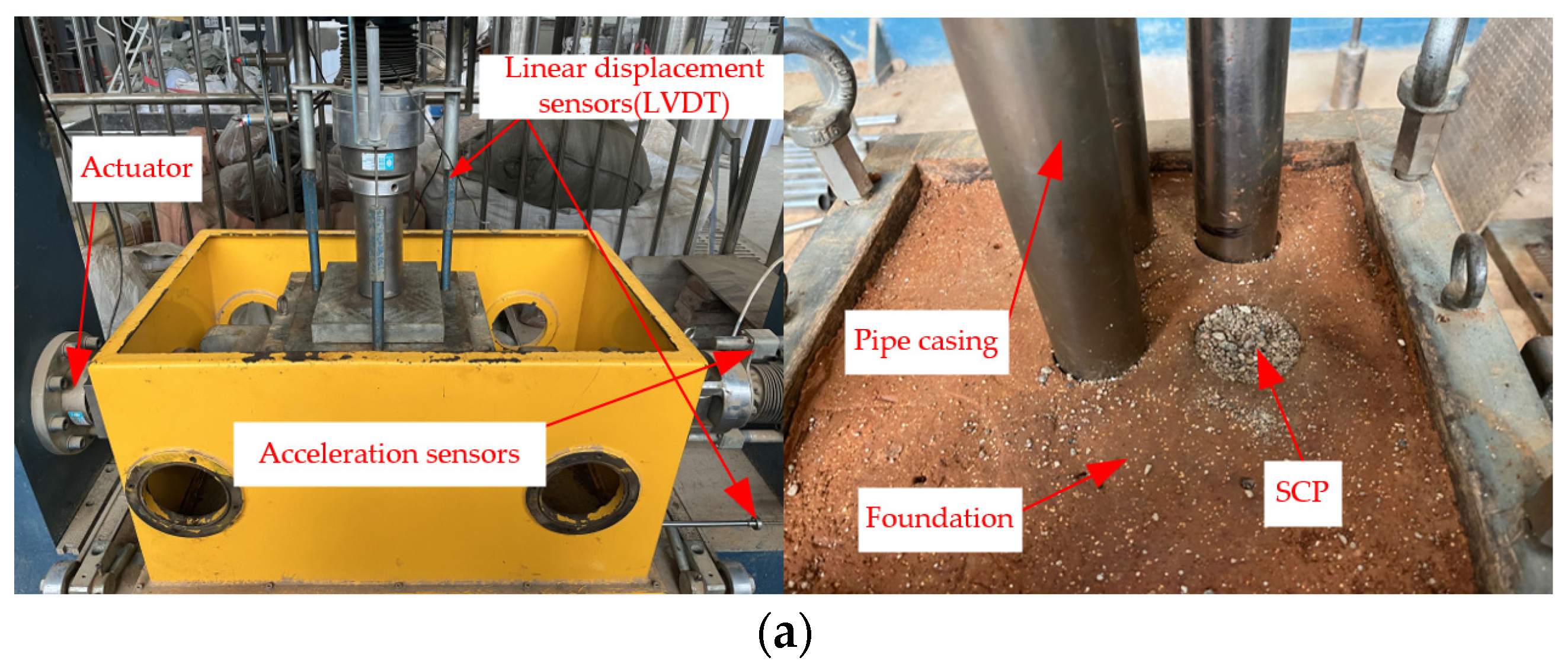

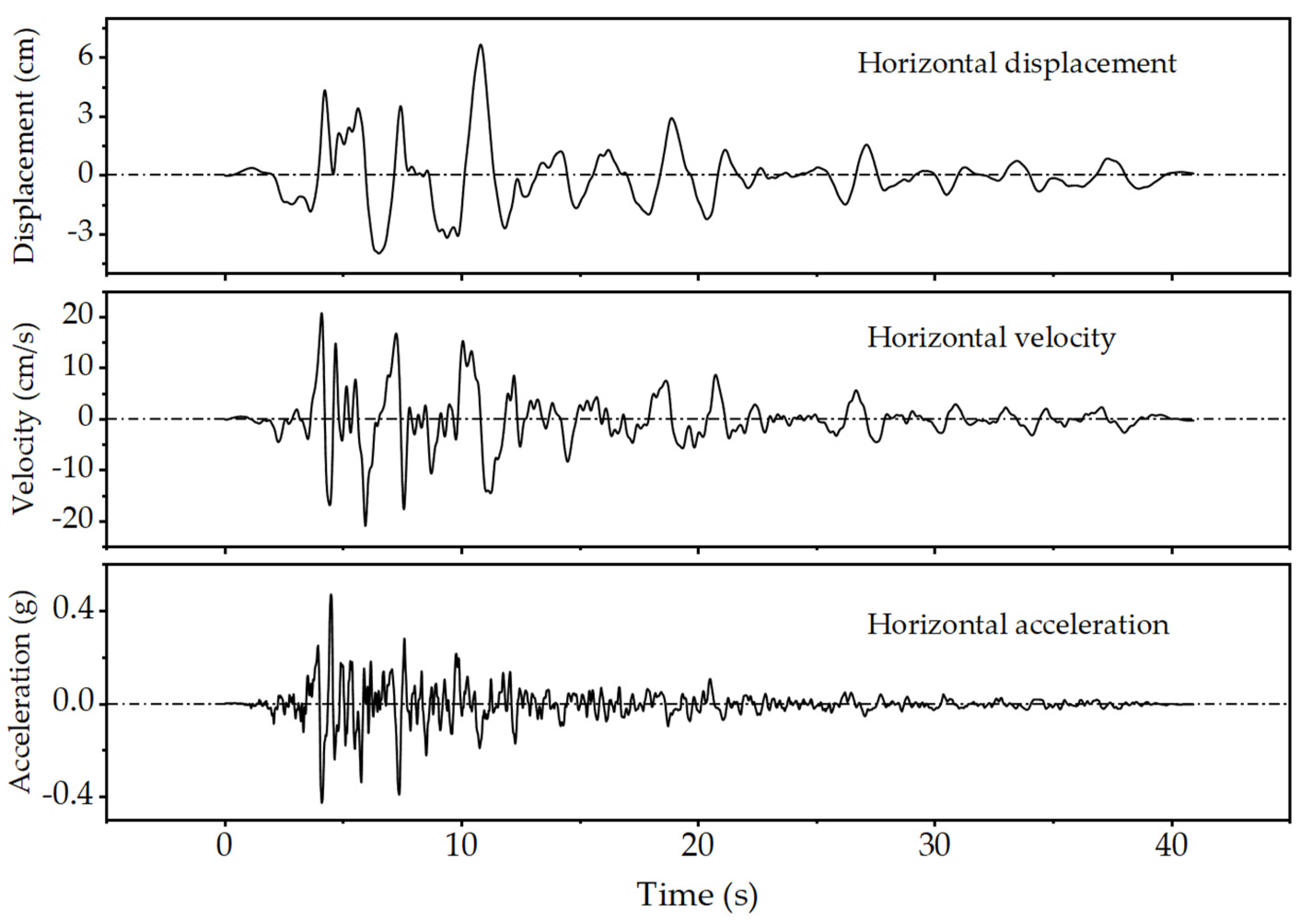
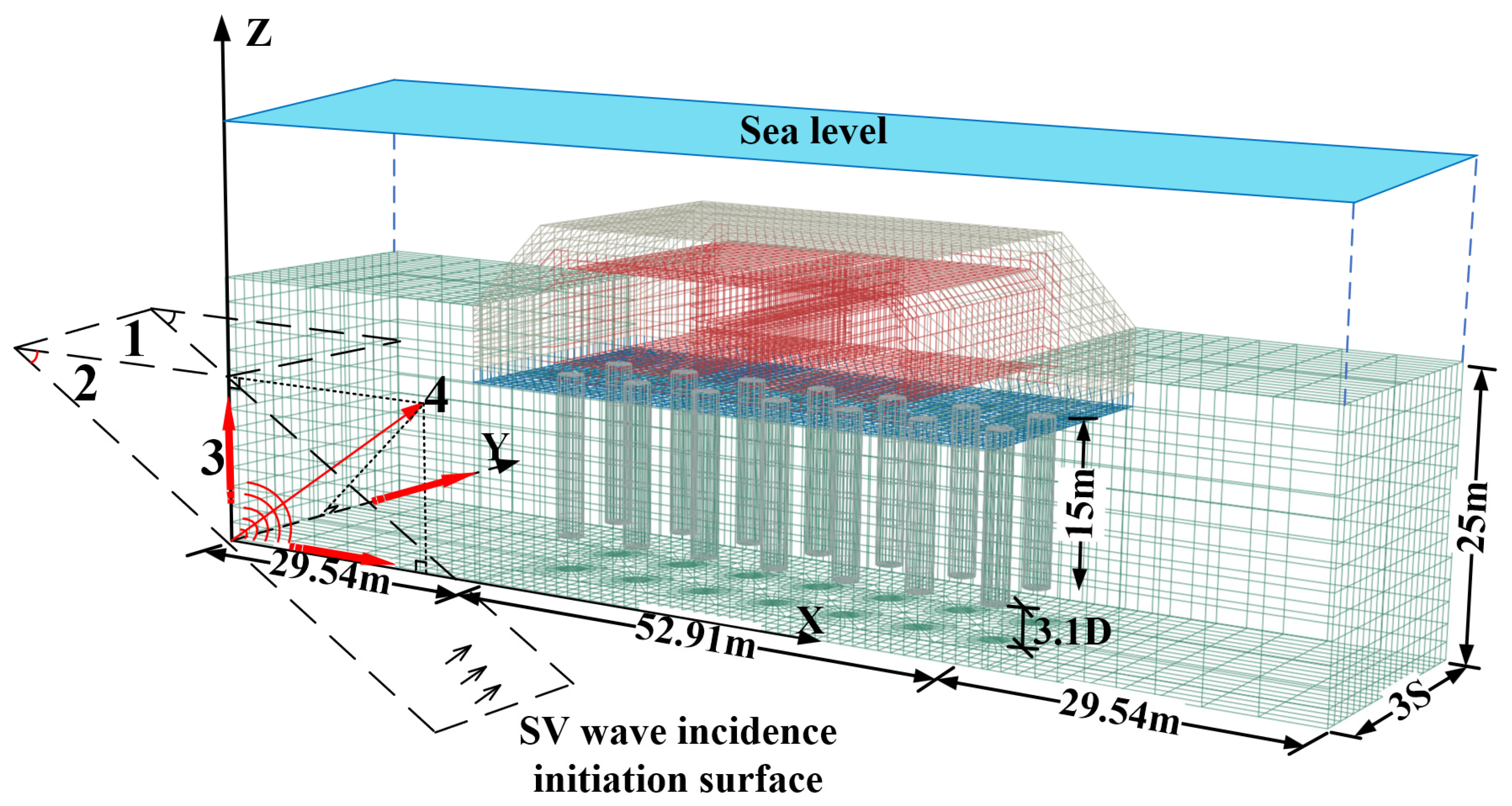
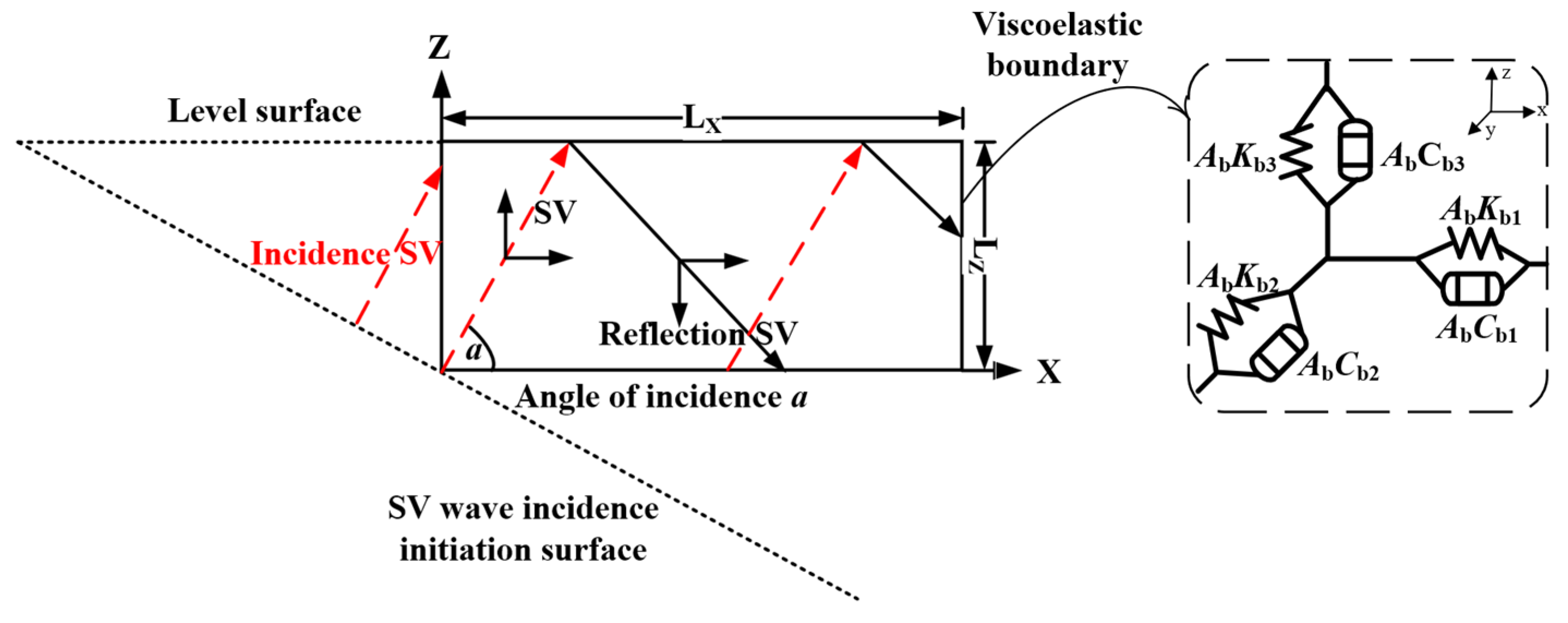
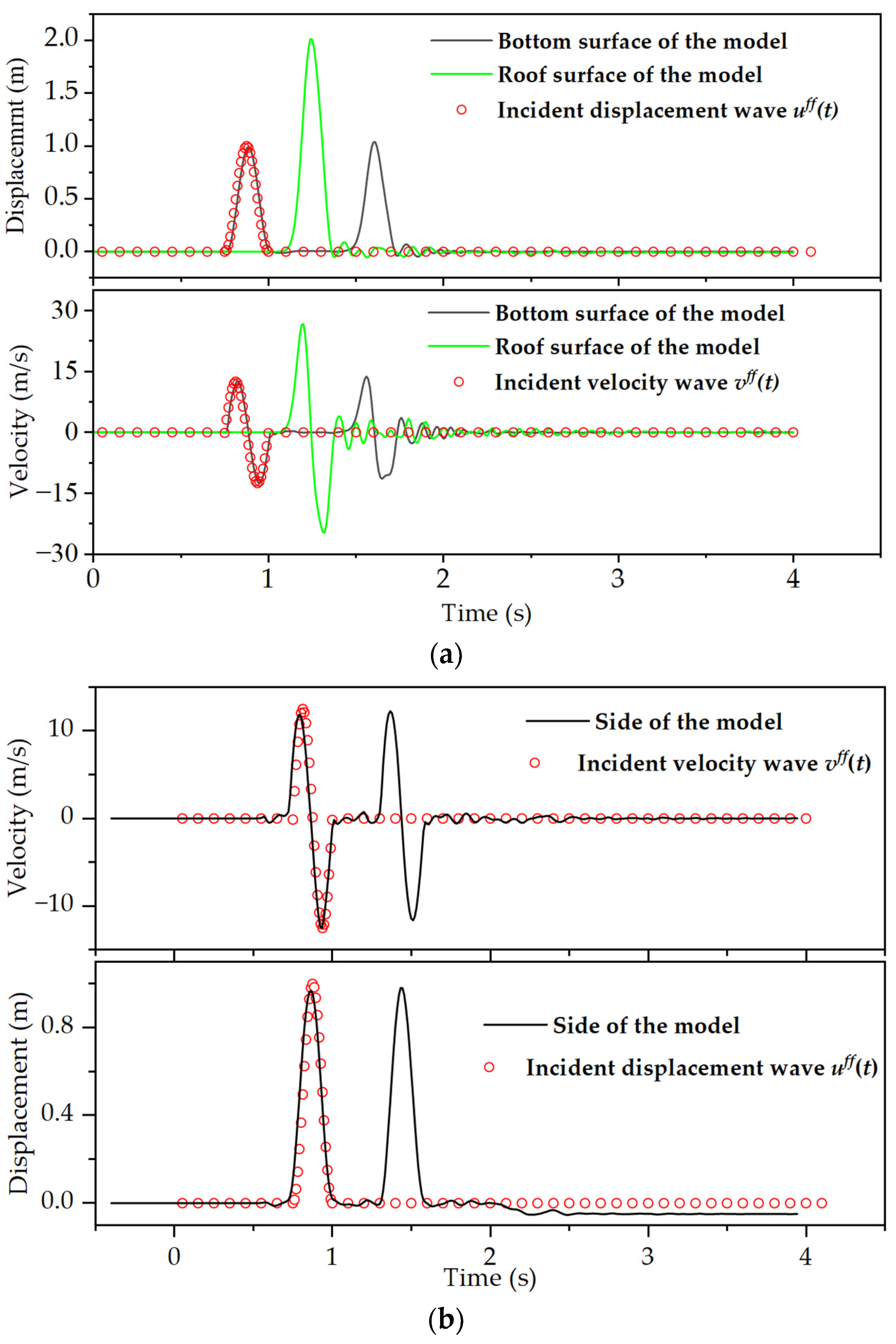

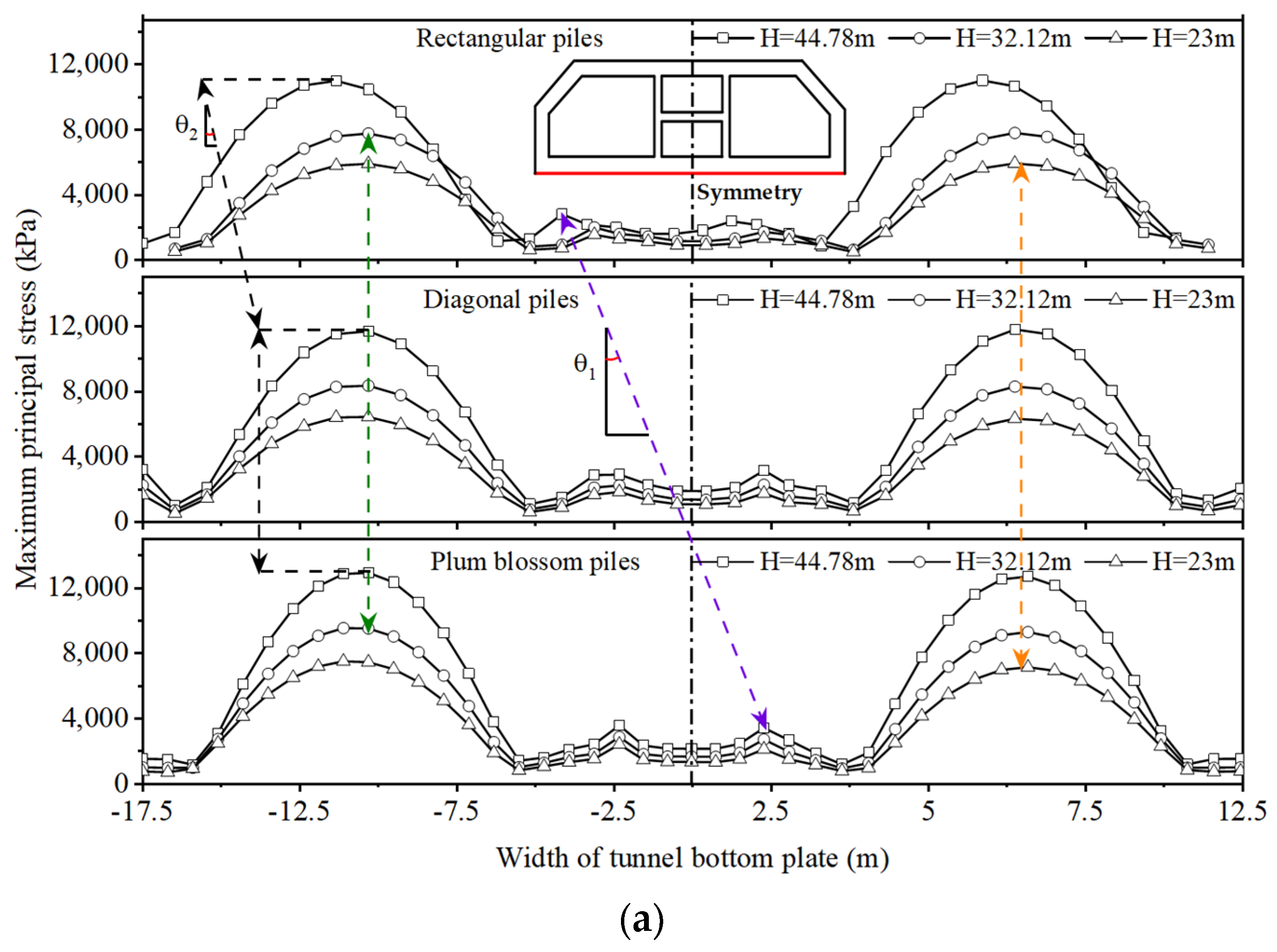
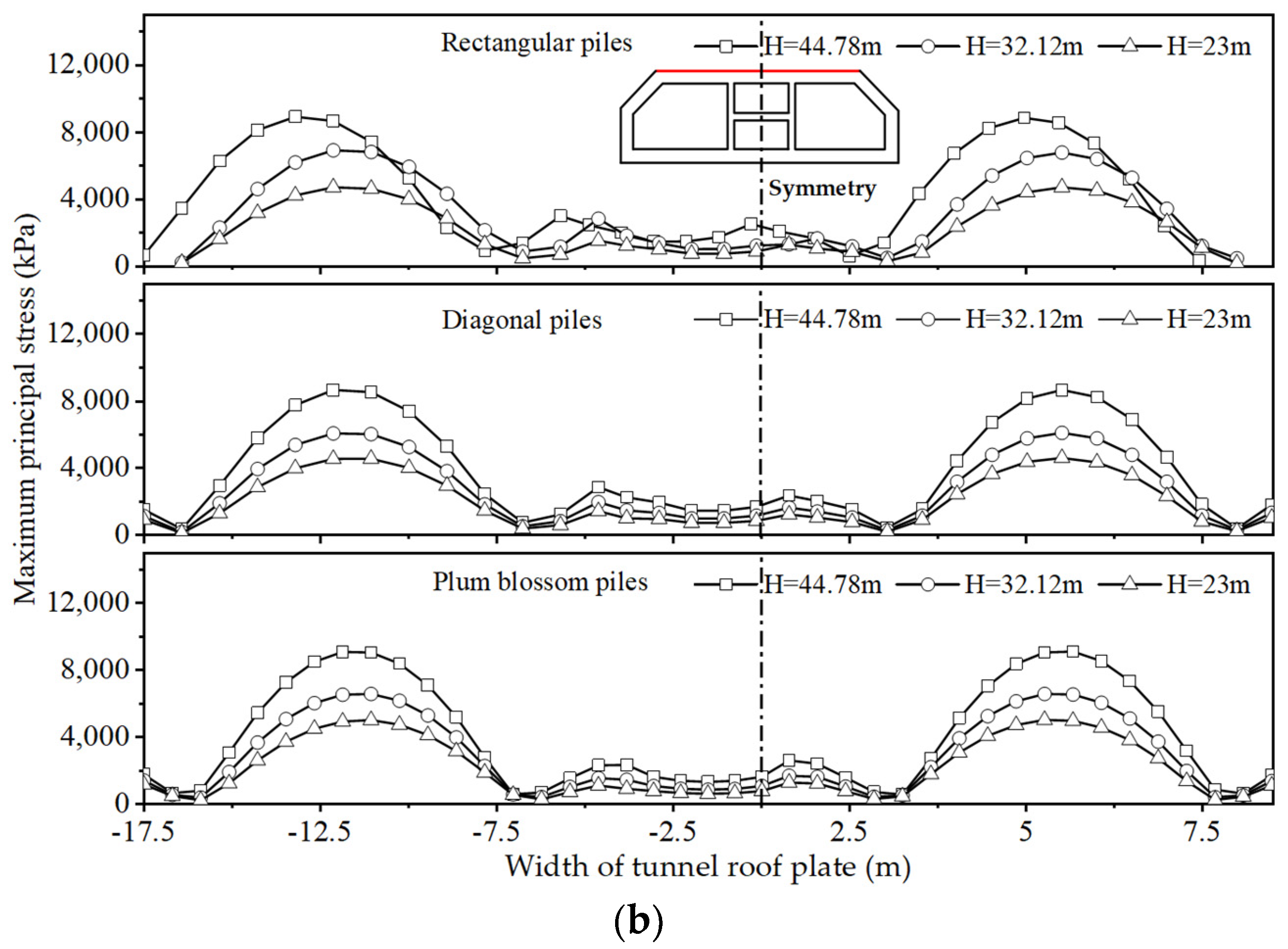
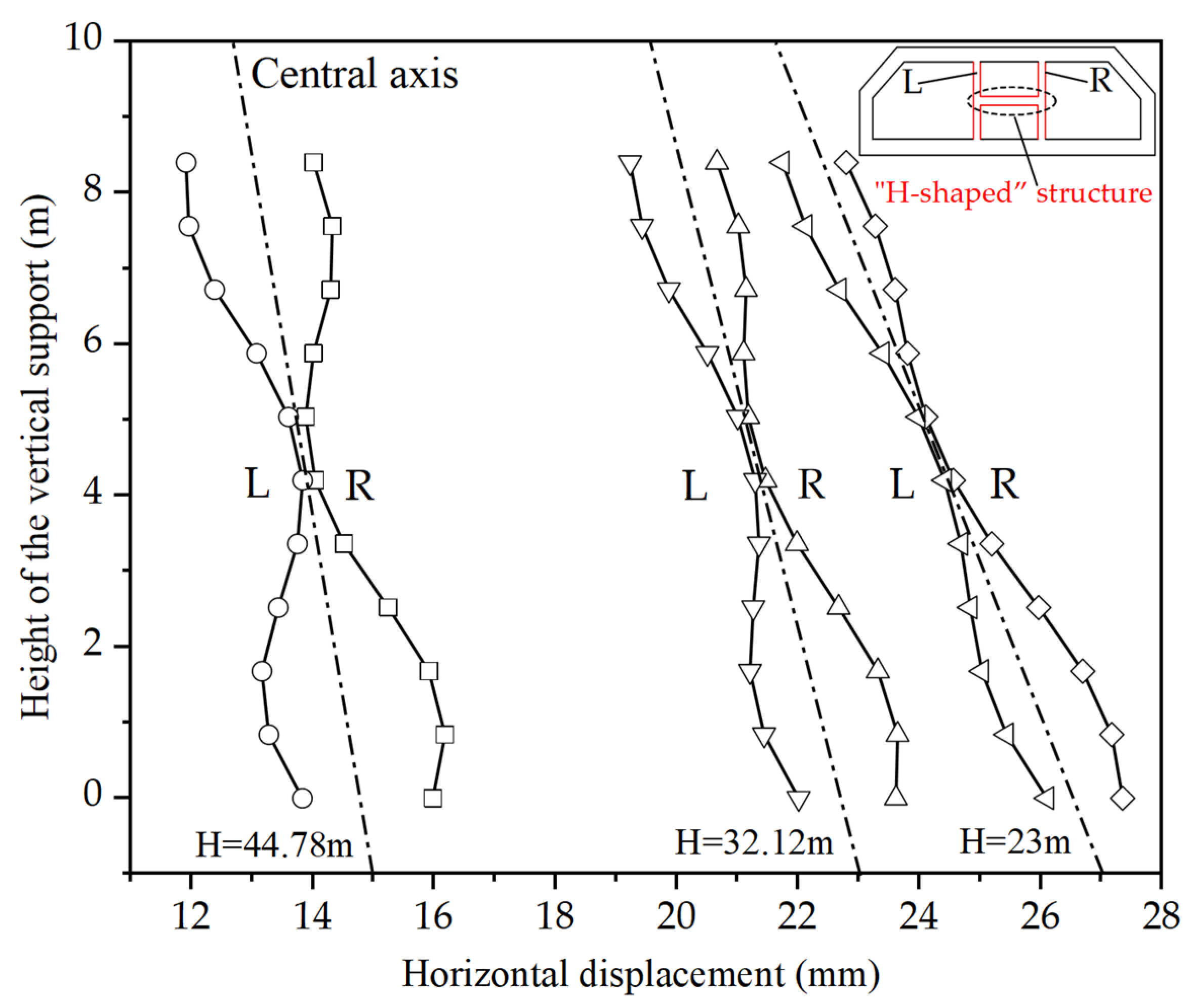

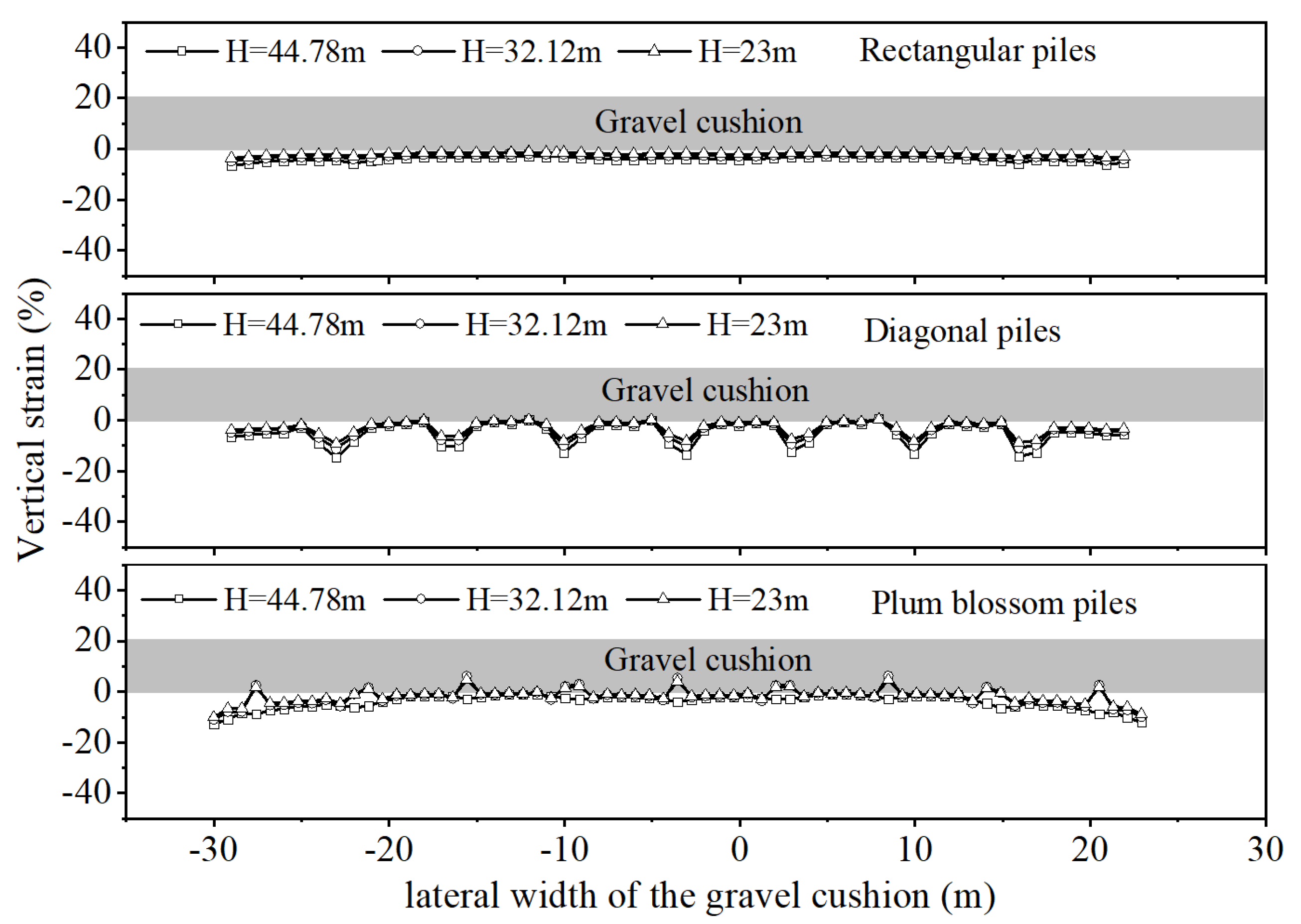
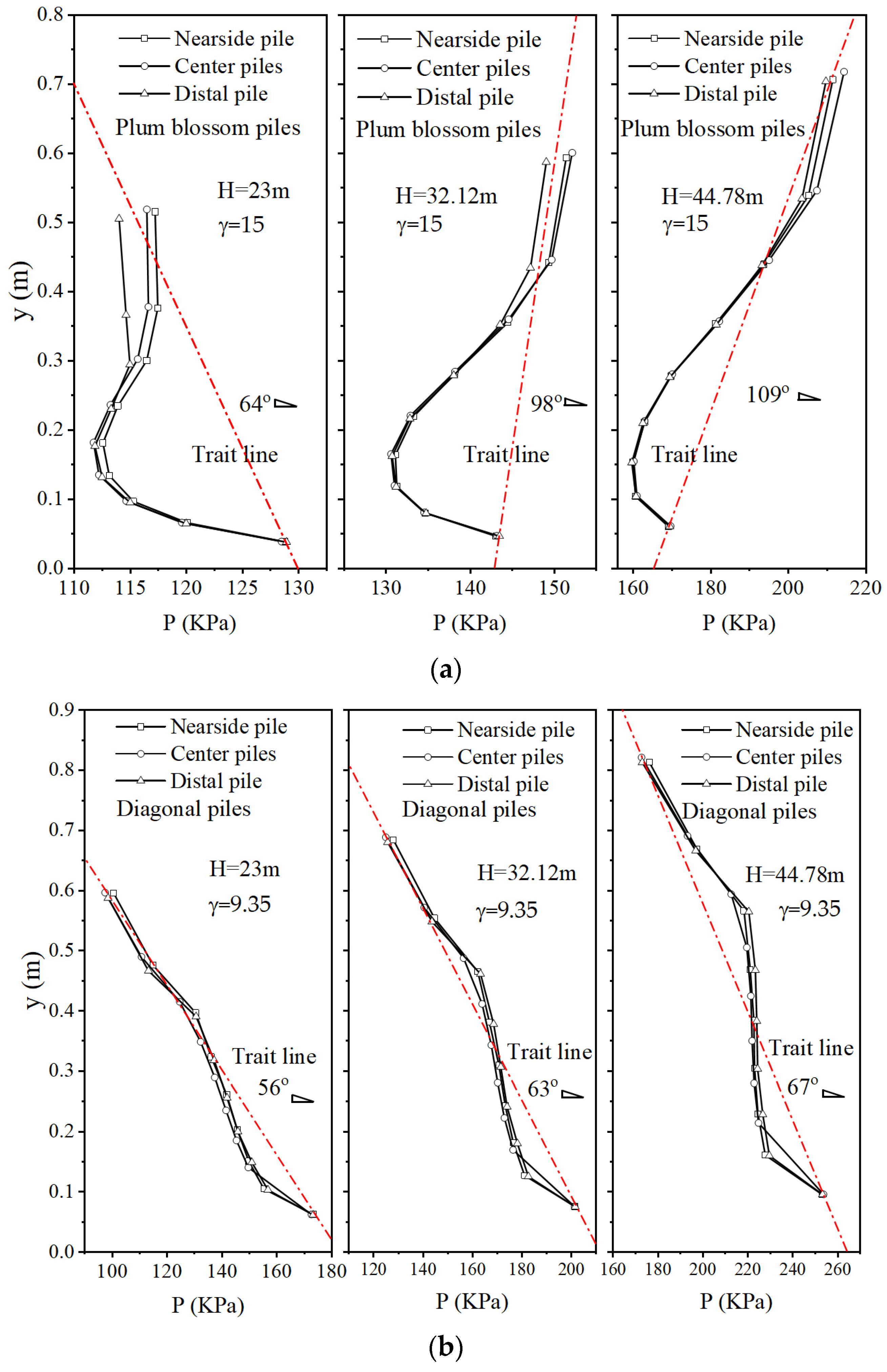

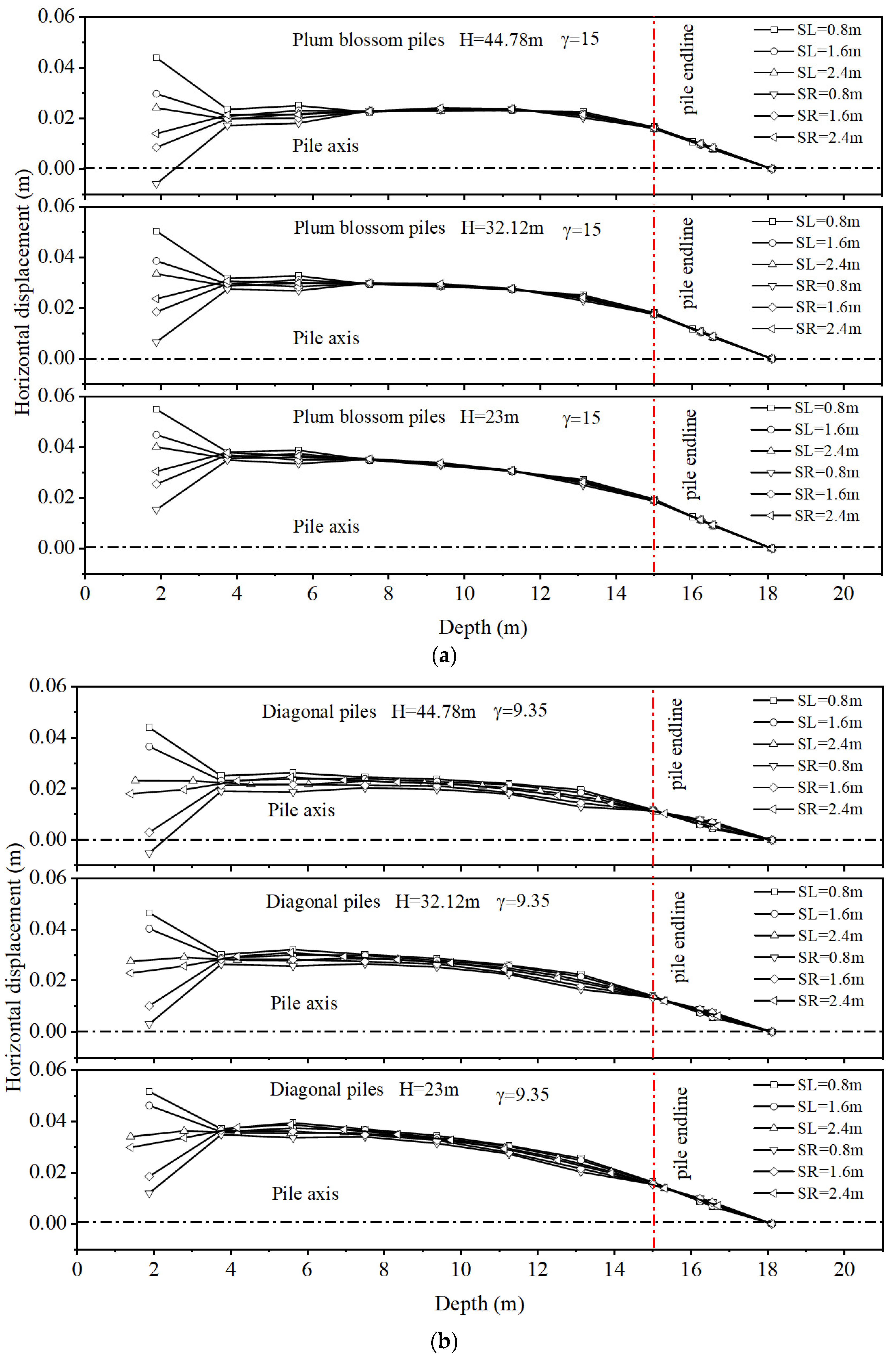
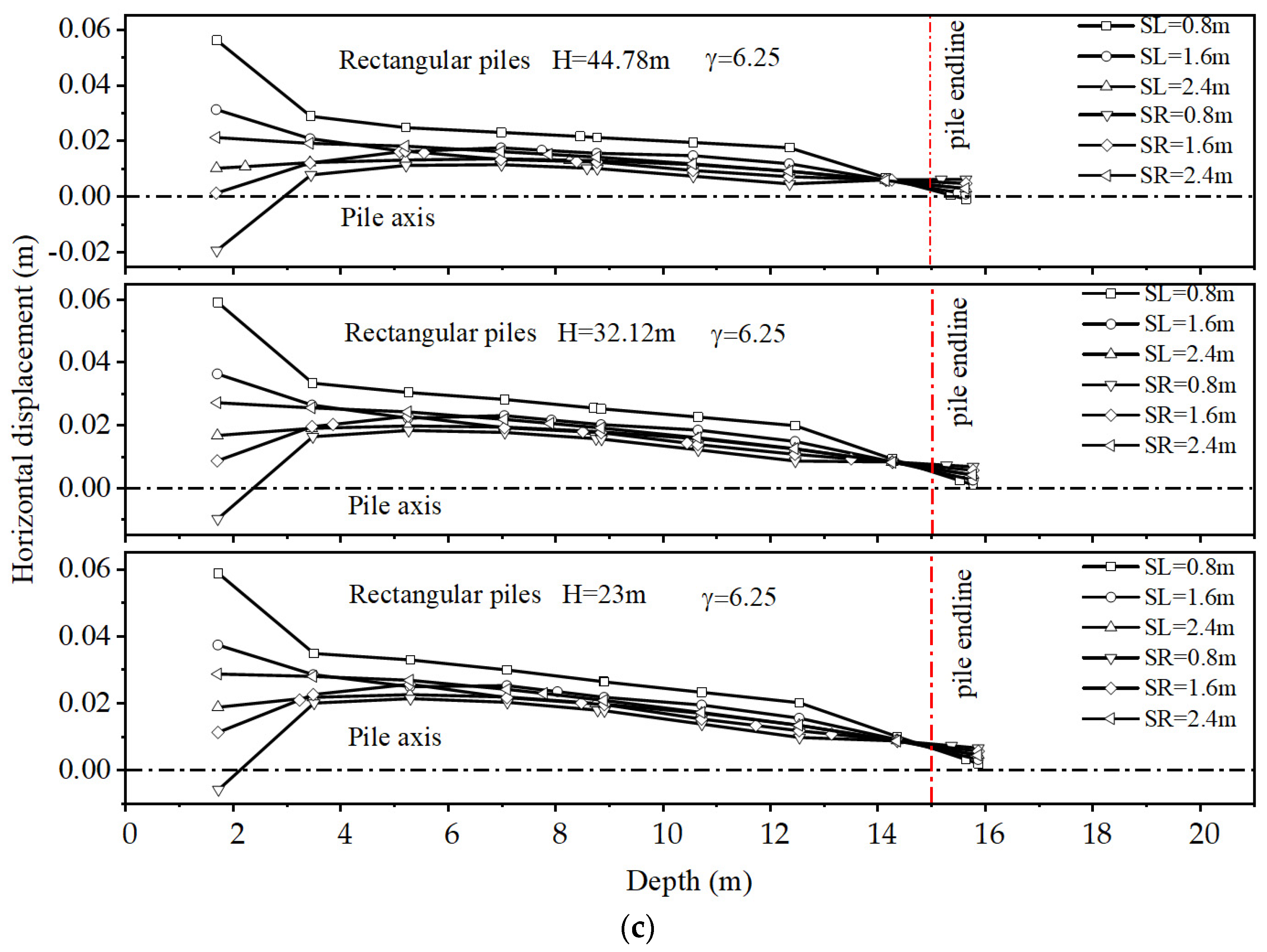
| Modeling Type | Component | Properties | M1 | M2 | M3 |
|---|---|---|---|---|---|
| Numerical model | SCP | Outer diameter [m] | 2.4 | 1.6 | 1 |
| Number × Length [m] | 14 × 15 | 23 × 15 | 25 × 15 | ||
| Foundation | Surface area [m2] | 52.91 × 3 S (Pile spacing) | |||
| Deformation modulus ES [kPa] | ES = ES* | ||||
| Physical model | SCP | Outer diameter [mm] | 48 | 32 | 20 |
| Number×Length [m] | 4 × 0.5 | 5 × 0.5 | 7 × 0.5 | ||
| Foundation | Surface area [m2] | 0.09 | |||
| Deformation modulus ES* [kPa] | ES* = ES | ||||
| Parameters | Marine Clay | SCP | Immersed | Gravel Cushion | Backfill |
|---|---|---|---|---|---|
| Consolidation index, λ | 0.113 | 0.023 | |||
| Swelling index, Kr | 0.05058 | 0.0103 | |||
| Critical state parameter, M | 0.668 | 1.2 | |||
| Poisson’s ratio, ν | 0.36 | 0.3 | 0.17 | 0.45 | 0.37 |
| Density, ρ (g/m3) | 1.851 | 1.765 | 2.45 | 0.9 | 2 |
| Buoyant density, ρw (g/m3) | 0.801 | 0.715 | 1.4 | 0.85 | 0.95 |
| Cohesion, C (KPa) | 7.4 | 0.5 | |||
| Friction angle φ (°) | 15 | 30 | |||
| Young’s modulus, E (KPa) | 2821.83 | E* | 30,000 | 20,000 | 150,000 |
| Permeability, κ (m/s) | 1.8 × 10−8 | 3 × 10−5 | |||
| Coefficient of lateral pressure | 0.577 | 0.5 | |||
| Initial void ratio, e0 | 1.059 | 0.72 | |||
| Degree of saturation | 1 | 1 |
Disclaimer/Publisher’s Note: The statements, opinions and data contained in all publications are solely those of the individual author(s) and contributor(s) and not of MDPI and/or the editor(s). MDPI and/or the editor(s) disclaim responsibility for any injury to people or property resulting from any ideas, methods, instructions or products referred to in the content. |
© 2023 by the authors. Licensee MDPI, Basel, Switzerland. This article is an open access article distributed under the terms and conditions of the Creative Commons Attribution (CC BY) license (https://creativecommons.org/licenses/by/4.0/).
Share and Cite
Zhuang, Y.; Fan, H.; Hu, S.; Chen, Z. Deformation and Stress Analysis of Pile-Supported Immersed Tunnels under Seismic Loads. Appl. Sci. 2023, 13, 12092. https://doi.org/10.3390/app132212092
Zhuang Y, Fan H, Hu S, Chen Z. Deformation and Stress Analysis of Pile-Supported Immersed Tunnels under Seismic Loads. Applied Sciences. 2023; 13(22):12092. https://doi.org/10.3390/app132212092
Chicago/Turabian StyleZhuang, Yan, Hu Fan, Shunlei Hu, and Zhi Chen. 2023. "Deformation and Stress Analysis of Pile-Supported Immersed Tunnels under Seismic Loads" Applied Sciences 13, no. 22: 12092. https://doi.org/10.3390/app132212092
APA StyleZhuang, Y., Fan, H., Hu, S., & Chen, Z. (2023). Deformation and Stress Analysis of Pile-Supported Immersed Tunnels under Seismic Loads. Applied Sciences, 13(22), 12092. https://doi.org/10.3390/app132212092





